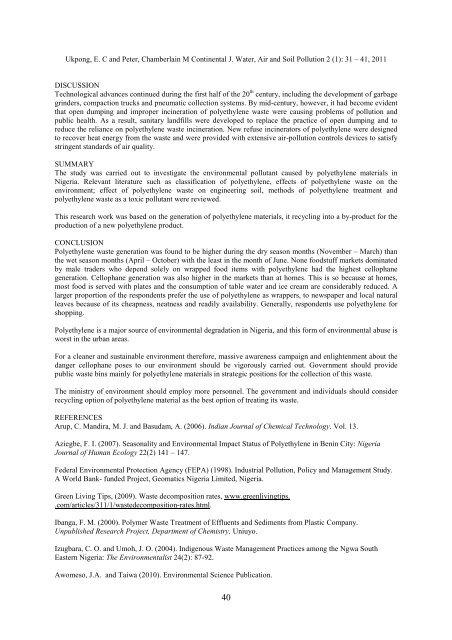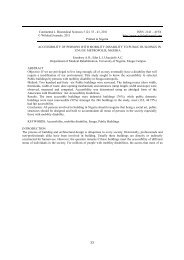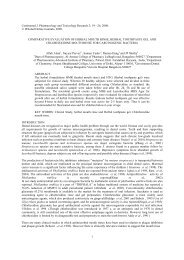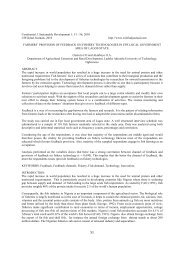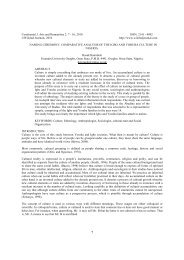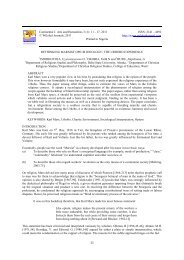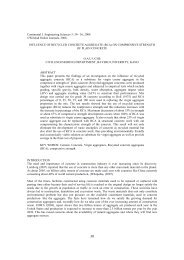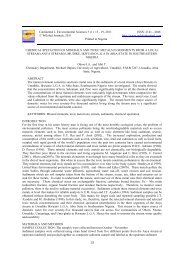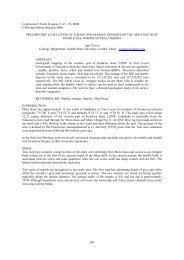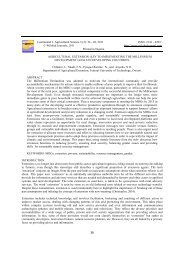Vol 2 _1_ - Cont. J Water, Air and Soil Pollution - Wilolud Journals
Vol 2 _1_ - Cont. J Water, Air and Soil Pollution - Wilolud Journals
Vol 2 _1_ - Cont. J Water, Air and Soil Pollution - Wilolud Journals
You also want an ePaper? Increase the reach of your titles
YUMPU automatically turns print PDFs into web optimized ePapers that Google loves.
Ukpong, E. C <strong>and</strong> Peter, Chamberlain M <strong>Cont</strong>inental J. <strong>Water</strong>, <strong>Air</strong> <strong>and</strong> <strong>Soil</strong> <strong>Pollution</strong> 2 (1): 31 – 41, 2011DISCUSSIONTechnological advances continued during the first half of the 20 th century, including the development of garbagegrinders, compaction trucks <strong>and</strong> pneumatic collection systems. By mid-century, however, it had become evidentthat open dumping <strong>and</strong> improper incineration of polyethylene waste were causing problems of pollution <strong>and</strong>public health. As a result, sanitary l<strong>and</strong>fills were developed to replace the practice of open dumping <strong>and</strong> toreduce the reliance on polyethylene waste incineration. New refuse incinerators of polyethylene were designedto recover heat energy from the waste <strong>and</strong> were provided with extensive air-pollution controls devices to satisfystringent st<strong>and</strong>ards of air quality.SUMMARYThe study was carried out to investigate the environmental pollutant caused by polyethylene materials inNigeria. Relevant literature such as classification of polyethylene, effects of polyethylene waste on theenvironment; effect of polyethylene waste on engineering soil, methods of polyethylene treatment <strong>and</strong>polyethylene waste as a toxic pollutant were reviewed.This research work was based on the generation of polyethylene materials, it recycling into a by-product for theproduction of a new polyethylene product.CONCLUSIONPolyethylene waste generation was found to be higher during the dry season months (November – March) thanthe wet season months (April – October) with the least in the month of June. None foodstuff markets dominatedby male traders who depend solely on wrapped food items with polyethylene had the highest cellophanegeneration. Cellophane generation was also higher in the markets than at homes. This is so because at homes,most food is served with plates <strong>and</strong> the consumption of table water <strong>and</strong> ice cream are considerably reduced. Alarger proportion of the respondents prefer the use of polyethylene as wrappers, to newspaper <strong>and</strong> local naturalleaves because of its cheapness, neatness <strong>and</strong> readily availability. Generally, respondents use polyethylene forshopping.Polyethylene is a major source of environmental degradation in Nigeria, <strong>and</strong> this form of environmental abuse isworst in the urban areas.For a cleaner <strong>and</strong> sustainable environment therefore, massive awareness campaign <strong>and</strong> enlightenment about thedanger cellophane poses to our environment should be vigorously carried out. Government should providepublic waste bins mainly for polyethylene materials in strategic positions for the collection of this waste.The ministry of environment should employ more personnel. The government <strong>and</strong> individuals should considerrecycling option of polyethylene material as the best option of treating its waste.REFERENCESArup, C. M<strong>and</strong>ira, M. J. <strong>and</strong> Basudam, A. (2006). Indian Journal of Chemical Technology, <strong>Vol</strong>. 13.Aziegbe, F. I. (2007). Seasonality <strong>and</strong> Environmental Impact Status of Polyethylene in Benin City: NigeriaJournal of Human Ecology 22(2) 141 – 147.Federal Environmental Protection Agency (FEPA) (1998). Industrial <strong>Pollution</strong>, Policy <strong>and</strong> Management Study.A World Bank- funded Project, Geomatics Nigeria Limited, Nigeria.Green Living Tips, (2009). Waste decomposition rates, www.greenlivingtips..com/articles/311/1/wastedecomposition-rates.html.Ibanga, F. M. (2000). Polymer Waste Treatment of Effluents <strong>and</strong> Sediments from Plastic Company.Unpublished Research Project, Department of Chemistry, Uniuyo.Izugbara, C. O. <strong>and</strong> Umoh, J. O. (2004). Indigenous Waste Management Practices among the Ngwa SouthEastern Nigeria: The Environmentalist 24(2): 87-92.Awomeso, J.A. <strong>and</strong> Taiwa (2010). Environmental Science Publication.40


